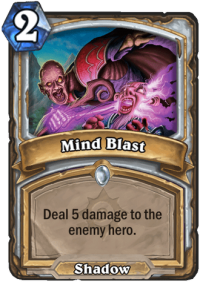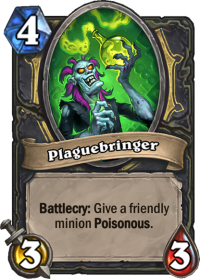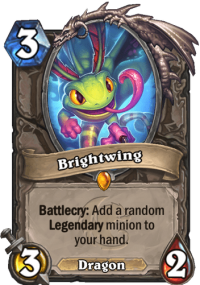Team 5 continues to increase the pace of changes made to Hearthstone with a Hall of Fame-related announcement out of the blue, along with a smattering of new cards in the Basic set to replace them alongside the old ones still waiting for a substitute. The blog post announcing this also went to great lengths to articulate the developers’ vision for the different class identities in the game, and it should serve as an interesting blueprint for both them and us going forward.
The Ones We Lost

For the first time in Hearthstone’s history, Hall of Fame rotations were justified by class identity concerns rather than power level issues. In the early years of the game, neither Vanish nor Mind Blast saw Constructed play in serious decks as they indeed didn’t fit into any strategies that they could pull off with the tools available to them. As the number of cards in the game (and eventually in the Standard format) kept rising, the more they managed to get done, and their fundamentally uninteractive nature coupled with the obnoxious levels of support required for them to achieve any level of playability makes these fairly harmless candidates for rotation. Burn-based Priest finishers are likely a thing of the past, but considering the class has been deprived of strong Control tools for a while – at least in part because of this –, this could be a brave new world. Resurrect effects will also be a lot less frustrating to play against this way.
Since this is the first time Basic cards are rotated out (the other ones were all from the Classic set and therefore had a rarity gem), both Mind Blast and Vanish seem to have received a Common designation, which is an interesting if minor precedent set for the future.
As for the class identity considerations outlined by the blog post, most of them are perfectly in line with what we think of when we look at them. They also serve as implicit rebuffs of some of the cards created under Ben Brode’s watch. Warlock’s “big healing” weakness would like to say hello to Lesser Amethyst Spellstone, just like Warrior’s supposed troubles against minion swarms didn’t mesh well with Reckless Flurry and Warpath. Similarly, Hunter’s limitation on card generation didn’t really match up with its Death Knight. This mini-reference bible also implies that certain archetypes are likely not going to get enough support going forward to be meta-defining. Paladin’s Control aspect only seems to be supported by healing on an archetypal level, which has never been enough to make such decks work. It also seems like Shaman won’t get enough card draw for a dedicated Combo deck again. Similarly, Rogue’s stalling options will likely be extremely limited in the future, especially after the removal of Vanish.
The Ones We Gained
Most of the new Basic cards are clearly meant to be interesting rather than good, but they do not at all conform to a baseline power level. The fact that they’re not meta-definingly strong makes sense, if only because of the lowered impact of the evergreen sets due to the larger overall Standard card pool. Some of them could very well find some niche role to play in particular formats or metagames. Here’s a snap verdict strictly based on our first impressions:

Plaguebringer: Fantastically elegant design. With Shaman’s Windspeaker, this can walk straight into the evergreen sets without looking out of place. Since Plague Scientist never saw Constructed play, this will likely not make the cut either, but by the same token, it is a more than reasonable Arena card for a class already armed with a plethora of premium tools in the game’s draft-based format.
Radiance: As the blog post itself outlined, this is a neat little cheap spell for cycle purposes (Grave Horror fans, rejoice!), though it’s strictly worse than both Flash Heal and Binding Heal. Considering Mind Blast’s rotation to the Hall of Fame, this makes sense: it’s strictly a face heal where the intrinsic value seems to be coming from its cheapness and the things Priest can do with those.
Siegebreaker: This Warlock card only drops two stat points for the Taunt and Demon tags, and its card text is therefore understandably weak. Veteran Arena players may remember the domination of Bog Creeper in the past, meaning this card will be excellent in the format just because of its high health total. With enough Demon synergies, this could be a viable defensive option.
Gift of the Wild: An absolute “feast or famine” kind of card which can easily find home in particular Token Druid builds as a different kind of win condition. In certain late-game scenarios, an 8-mana Savage Roar is good enough, though it will require very specific metagames to be viable without the ramp tools lost by the class.
Righteousness: This could turn out to be one of the stronger cards out of the bunch. For a midrange/tempo Paladin deck, this can serve as AoE protection when they’re ahead of the board, and this fact by itself means this card shouldn’t be discounted. It also pretty much instantly wins a hypothetical mirror match, much like AoE buffs instantly settle a battle between two Token Druid players.

Brightwing: A nice little drop of value with a tribal tag attached – a decent “budget” option in Control decks for players with smaller collections and likely a good enough card to include in dedicated Dragon builds.
High Inquisitor Whitemane: Remember Kel'Thuzad? The problem with cards like these is that they’re only effective if you have a late-game contested board state to deal with, which is very rarely a desirable situation for any archetype. Aggro decks expect to be fully face-focused at that point while Combo and Control decks often play off the board, relying on spells to provide the initiative. As such, it’s hard to envision an archetype where this card warrants inclusion.
Barrens Stablehand: RNG fans could have some fun with this card but it’s useless in Constructed. Contrast and compare with Silver Hand Knight.
SI:7 Infiltrator: Perhaps the most interesting card out of the bunch as it’s a neutral tech tool, one that’s possibly necessitated by the Specialist format. It’s well-statted, appropriately tuned for the very different value outcomes by its effect for the different matchups (and way less impactful than Kezan Mystic used to be). It’s great to see more viable tech choices in the evergreen sets.
Arcane Devourer: This card is way too slow for way too little payoff.

The loser of this Hall of Fame announcement is Mage.
*Jaina looks at Plaguebringer, then looks back at the Tome of Intellect and Icicle cards in her hands, then goes to cry in a corner*
Tome of Intellect is actually playable in a Miracle/Quest Mage deck. Plaguebringer looks pretty bad, and it’s unplayable in Wild because Plague Scientist is strictly a better card.
It’s not strictly better. I would argue that they’re quite similar. Plague Scientist is Combo, Plaguebringer is Battlecry – the difference is big (e.g. SI:7 Agent vs Fire Plume Phoenix). Plaguebringer also has 1 more Attack.
You can argue that one is better than the other (but like I’ve said, I think they’re on roughly the same power level), but neither of them is strictly better.
I think you just gave an example that perfectly proves my point: SI:7 Agent has been a staple in Rogue forever, whereas Fire Plume Phoenix has only been played in aggressive decks that cared about the Elemental tag (Even Shaman, Elemental Shaman…). I never saw a Rogue deck with Fire Plume Phoenix. Plaguebringer could still see play in a Standard meta that’s favorable to it, but if Plague Scientist were still around, that’s the card that would see play. People argue that Plaguebringer is great right now where Lackeys around. And precisely because of that Plague Scientist would be great too, because it would be very easy to enable the Combo.
My main point was that it’s not what “strictly better” means. A 3 mana 3/3 is strictly better than a 3 mana 2/3 with the same effect. 3 mana Fireball would be strictly better than a 4 mana Fireball.
But here, we’re paying 1 more mana for +1 Attack (good thing) and turning Combo into Battlecry (again, good thing). You can say that one is better than the other, but neither is strictly better.
And again, I think that they are quite similar in terms of power level. When using SI:7 vs Fire Plume Phoenix as an example, you forgot that both of them have the same stats. In this case, 3-drop is a 2/3 and 4-drop is a 3/3. How much play would SI:7 Agent see as a 2/3? It’s hard to say, but definitely much less than it does right now. If it was a 2/3, I’d say that both him and Phoenix would be on about the same power level. Same goes for the cards here, in my opinion.
Plague Scientist existed in a world where Frost Lich Jaina and Bloodreaver Gul’dan and Deathstalker Rexxar battled Togwaggle Druid and Quest Rogue. With that kind of power level and Rogue deck archetypes, it saw no competitive play.
Plaguebringer will be an evergreen card, which I think it could be teched into meta decks right away.
That is head and shoulders above the old Hall of Fame replacement cards, which are among the weakest cards in the game.
You are right that Plaguebringer could still see play in a Standard meta that’s favorable to it, but if Plague Scientist were still around, that’s the card that would see play. People argue that Plaguebringer is great right now where Lackeys around. And precisely because of that Plague Scientist would be great too, because it would be very easy to enable the Combo.
I agree that the HoF replacement cards are generally horrible. We obviously didn’t want Fireballs or Ice Bolts, but we also didn’t want Silverback Patriarchs nor Magma Ragers.
How is Mage a loser? Sure neither Tome of Intellect or Icicle are particularly strong cards. But neither is Plaguebringer. It gives Rogue another form of single target removal, but compares poorly with most of the other STR’s Rogue already has.
I think Plaguebringer is quite strong. Rogue decks already tech in Walk the Plank against Mountain and Sea Giants and huge magnetized threats, and I think Plaguebringer is often a superior choice.
You sacrifice a 1/1 lackey or cable rat to kill the giant enemy threat, but gain a 3/3 body in return, at least when compared to Walk the Plank. It has a limitation (need a minion to bump into the enemy threat), but so does Walk the Plank (enemy minion must be undamaged).
The limitation is far more detrimental than the value gained when you get a 3/3 (in *exchange* for some existing minion). There isn’t one pro who thinks the card will see play. You are living in a fantasy world.
I wouldn’t be so categorical. For a start, walk the plank will rotate whereas this will not.
Then how about using it on a divine shield minion? Or the possibility of bouncing it back to hand for value trading?
It’s still not a great card, but still…